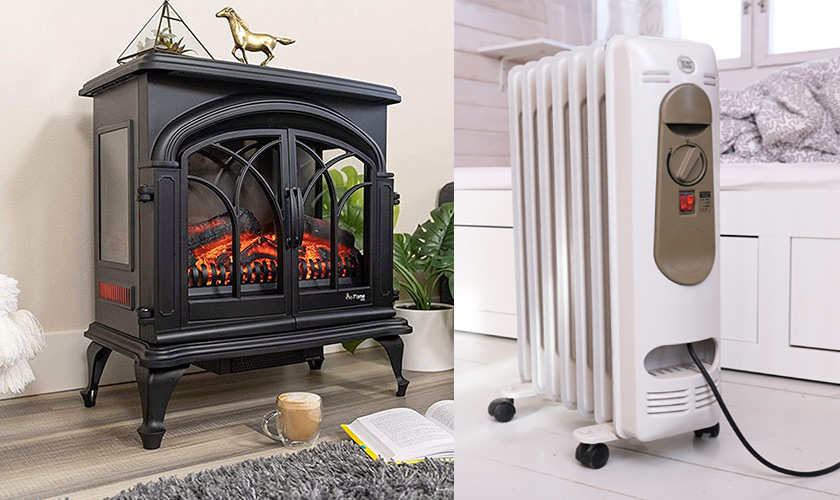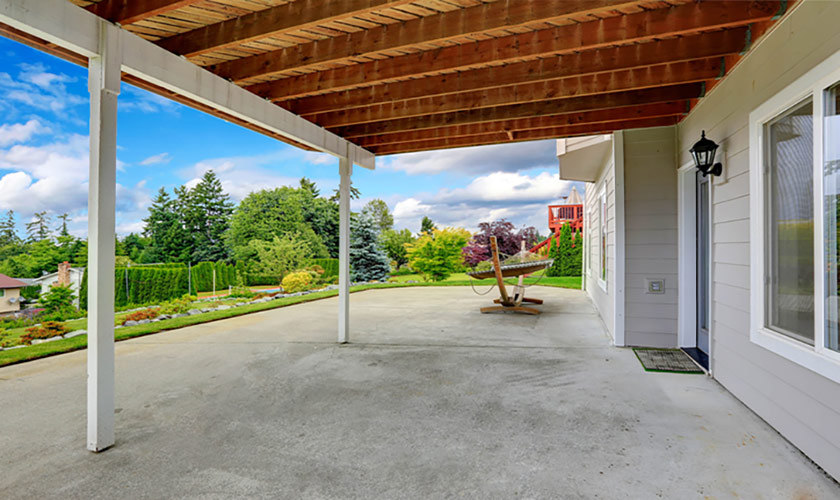
There are many ways one can create a stunning and enjoyable home and garden, but having a patio is probably one of the things which can improve the outdoor-home experience the most.
The garden grilling sessions, late-night cocktail parties, or Halloween parties outside can be some of the most memorable experiences of a year. However, it is frustrating that you cannot use a patio for months due to the weather.
Using a patio can become a challenge in wintertime due to the cold, wind, rain, or even snow! But a patio heater can help you enjoy the fresh air, whatever the weather.
It can easily keep a patio warm enough to allow people to spend hours there. Many people fear using their patio heater in the winter because of snow, ice, and the cold. In this article, we will answer the question: Do patio heaters work in the winter?
Patio heaters work in the winter, and they are also one of the best options you have for heating your patio in cold weather due to the radiating heat they provide.
This article is for you if you plan to build or maker making one in your garden and are worried about managing the heating in the colder seasons.
We have compiled all you need to know about how these patio heaters work, how effective they are, and how to use them as well. Read on if you want to find out more!
How Do Patio Heaters Work?
So, when talking about ways to heat your patio, more specifically about patio heaters, the most important thing one has to know is how these patio heaters work.
Before purchasing a patio heater, one must be aware of some essential components, fuels, temperatures, and what these devices are made and capable of. In this section of today’s article, that is what we will be looking at.
There are several different types of patio heaters, but the first characteristic to distinguish them is probably their energy source.
There are typically three types of patio heaters broken down by fuel type:
- Those that run on electricity
- Propane gas
- Natural gas
The more “extravagant” products use other fuels, but these are the fuels used in 99% of patio heaters.
There are also different types of patios for shape and build type, such as the quartz tube types, mushroom style patio heaters, fireplaces, wall-mounted heaters, etc.
Now, let’s talk about the way these patio heaters work. First, we have to clarify the idea of radiating heat, infrared rays, and everyday heat.
1. Radiant Patio Heaters
Radiant heater’s name comes from how they radiate heat constantly, in a constant and even flow. It isn’t like a fire where only a small area around it is heated up. It also heats the air around the heater itself. This way, radiating heat can spread evenly over large areas.
2. Infrared Patio Heaters
Regarding infrared patio heaters, they use technology that doesn’t heat the air but only the objects and the people it hits.
We would need to go into some unnecessary physics to discuss this, but this practically means that this won’t feel like opening an oven, but much more like you are not even in cold weather.
It is a beneficial and exciting technology that allows for more efficiency in outdoor heaters. Think about the sun if there is one analogy we could draw to illustrate how it works.
When you go outside on a warm day and have direct contact with the sun, you start warming up more than you would in the shade, where the rays don’t hit you directly. Due to the infrared radiators acting like the sun, it heats your clothes and skin.
When you turn on a propane gas patio heater, it sends the heat up a vertical pipe into the burning chamber, which is the one that generally has a mushroom-like “hat” or metallic dome on it.
The heat will travel horizontally before dissipating, allowing larger areas to be heated instantly, even in freezing temperatures.
3. Wall-mounted Propane Heaters
The same goes for wall-mounted propane gas heaters; only the design and efficiency are somewhat different. The burning isn’t captured in a tube but instead immediately pushed away towards the desired space to heat.
Wall-mounted heaters are relatively inefficient, which is why wall-mounted heaters usually work with infrared electric technology.
4. Electric Heaters
The system is pretty much the same with electric heaters, except you will need a cord to provide the electricity, so it isn’t as mobile as a propane heater.
The significant difference is that these versions draw heat from running electricity through certain metal types to generate heat. In contrast, propane or natural gas products use internal combustion to generate heat.
However, both rely on certain heating metals to certain degrees to provide radiation heat instead of convection heat.
electric heaters are also more customizable. They can be placed anywhere and are also easier to insulate. In a sense, they are more modern and often much more practical than their older, gas-fueled patio heaters.
Do Patio Heaters Work in the Winter?
So, now that we have covered the basics of how patio heaters function and what categories we can divide them into, we can talk about actually using them.
A patio heater’s job is to warm up the air in an otherwise cold area, meaning that you will primarily be using your patio heater from the beginning or middle of autumn to the center of spring.
The winter months like December or February will cause the most trouble out of these months, so the most critical question is: Do patio heaters work in the winter?
Well, yes, they work and can provide the heat you need to enjoy a wintertime marshmallow cooking outside or perhaps a hot chocolate date night on the patio.
However, you might have to research the exact type of patio heater you want to buy since not all are suitable for outdoor use in the winter.
Patio heaters are some of the best ways to heat patios in winter for efficiency and effectiveness. There are a couple of other options like a fireplace or something similar, but a patio heater’s purpose is heating an outdoor area, so it has an edge.
How Do I Keep My Patio Warm in the Winter?
So now we will get to the more practical aspects of using a patio heater in winter. Buying one or two heaters for your patio may be just what you need to enjoy that part of your yard during the colder months.
However, you don’t yet know how to place them, so they work best or, in general, how to use them. For that reason, in this part of today’s article, we will focus on keeping a patio warm in the winter!
1. Choose the Correct Heater Size
So, the first thing you have to do is decide the heaters you want to buy. You do this by measuring your patio area or the part of your patio that needs to be heated and checking how many patio heaters you will need for it.
One average patio heater, which runs on propane gas and is of the mushroom design, will radiate heat in a circle of about 6-10 feet.
Depending on your patio’s size and the patio heater you are looking at, you can choose the heater or heaters that you will use to heat your patio.
2. Pick the Best Area to Place Your Heater
Once you have enough heaters to keep your patio warm, you can start the setup. Strategically, pick the best spots on your balcony where you can place the heater or the heaters you want to use to heat the patio.
Make sure you don’t put the heater too close to any single chair since the person sitting there might feel like it is too warm, while someone a couple of feet away might feel too cold.
Try to position your heating devices to cover the most essential and functional part of your patio (or the part you want to use and heat, at least).
3. Warm the Area Up
With your devices chosen and strategically placed to provide ultimate comfort for you, your family, and your friends on the patio, you can go about warming the place up. You will need to know these three things:
- How do you warm it up?
- How often you’ll need the heater.
- To what extent you need it will depend on your situation, like during a specific event.
You might not even have to place the heaters directly on the deck, put them in your garage, and bring them out 30 minutes before you plan on sitting outside and try warming up the patio a bit before your guests arrive.
If you have money and a patio, you would rather see it free of snow and always warm (perhaps it is where a dog has their heated dog house?)
You will need to find a way to turn them on for a couple of hours and then turn them off for another couple of hours at a time. However, turning your heater off and on may cause damage, but it depends on your needs.
4. Customize Which Heater You Want
The best part is that you can truly customize it. You can buy one out of a thousand different types of patio heaters, each one better than the last one, and choose any kind that suits your goals the most.
If you need something that gets hot, get a propane heater. Still, if you have a more modern-looking patio, you should consider finding electric patio heaters for more convenience.
Are Patio Heaters Worth it in the winter?
Before we dive into our product recommendations, let’s discuss another crucial element of buying and using portable heaters, especially in winter. Are they even worth it?
You might have to buy propane refills, pay higher utility bills, or use up a lot of energy your solar panels (if you have them) create. In any way, it costs to maintain a warm patio, but are these patio heaters worth the fuss and the coin too? Let’s find out.
We believe that portable patio heaters are worth it for a few reasons:
- Pure functionality: You can take one or two pieces of metal out to your patio and have a BBQ to celebrate Christmas without feeling cold for a second.
- They don’t cost an awful lot: Aside from the possible events and activities you can organize outside, thanks to the patio heaters, they are worth it since they do not cost a lot to maintain.
Certain types of patio heaters run on literal pennies for an hour of heating. These are usually electric heaters that can automatically adjust the air, depending on the weather outside and your decision.
These heaters can save you a lot of money compared to the other forms of having fun outside in winter, so it is a blessing to be able to spend the coldest but most beautiful season of all outdoors once in a while. - Another reason that patio heaters are worth it is quite simply the fact that other products don’t have all that much to give.
Fireplaces and such do not radiate heat. A fireplace or fire pit has a heating circumference of a couple of feet. On the contrary, if you invest in a patio heater, you don’t have to worry about being cold on the patio. Patio heaters quickly clean up and store away, requiring little space due to their vertical design.
Best Patio Heaters for the Winter
In an article about patio heaters and their efficiency, it would be a sin not to provide at least a shortlist of great patio heaters you can buy which will make your winter insanely better.
For this reason, we have collected ten heaters, which we believe are the best. We will also mention that we have reviewed every patio heater on this list and concluded after testing them for one night each. We did ensure that our suggestions were based on authentic experience. Read on if you are interested!
The second most common category people are looking at is the budget category. You might need some efficient heating for a smaller space, or maybe your other patio heater doesn’t work, and you need a quick fix.
Many people look for budget options regardless, but this shouldn’t mean getting a low-quality product.
Some features (mainly design and build quality) will be less developed with the budget patio heaters. However, you can still get an excellent product for a lower price, like the Dr. Infrared Heater 1500W Patio Heater.
The infrared heater is also electric, but not a mushroom-styled one like the previous one that we mentioned. You can purchase a tripod to place it separately; otherwise, it is a wall- or ceiling-mounted device.
With three heat settings (900W, 1200W, and 1500W), you can adjust the amount of heat you want it to produce to heat your patio. It is also wholly environmentally friendly, with no greenhouse emissions.
Conclusion
Putting everything together, patio heaters are an excellent choice to use outside during winter! You can ensure that you will still be able to use your outdoor living space comfortably.











